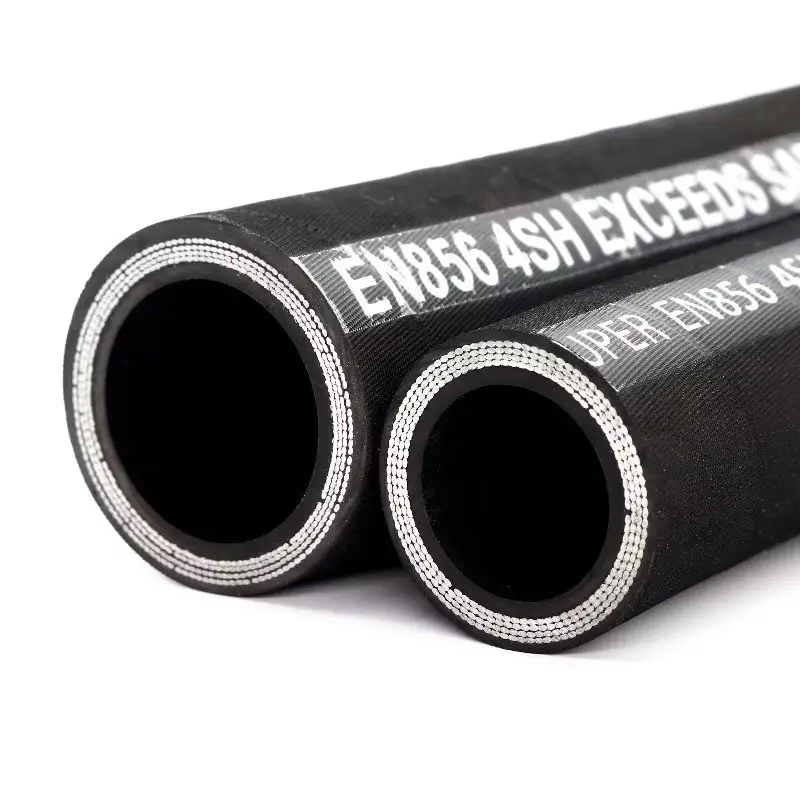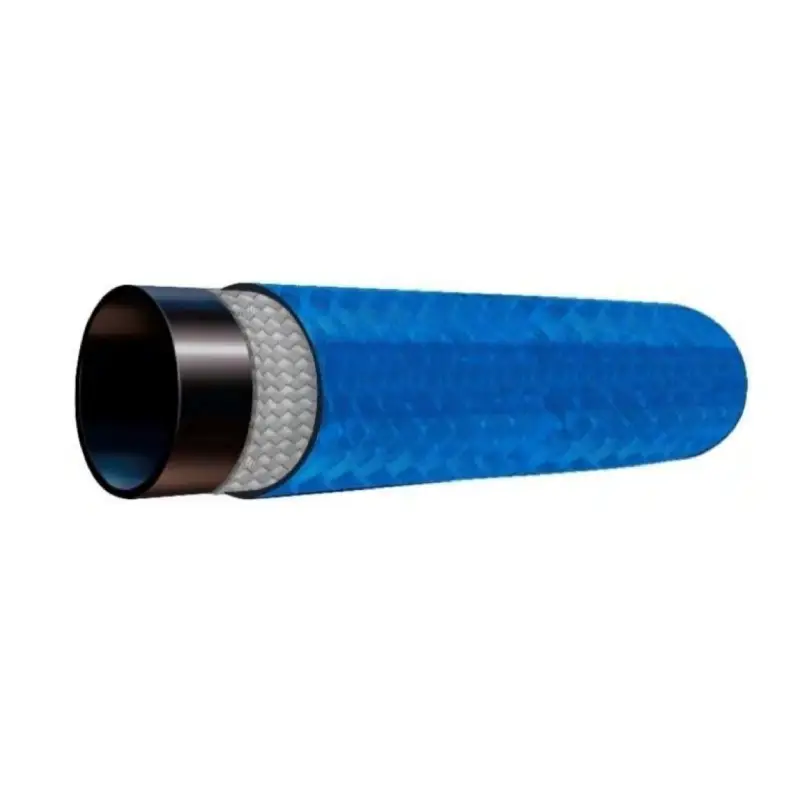High Temperature Hydraulic Hose
We provide high-temperature hydraulic hoses designed to withstand extreme operating environments. Our hoses are engineered with specialized materials and construction techniques to maintain flexibility and performance in high-temperature applications, ensuring optimal system reliability and longevity.

High Temperature Hydraulic Hose 4SP4SH
We supply high-temperature hydraulic hoses specifically designed to operate in demanding environments. Constructed with specialized materials and advanced manufacturing techniques, these hoses maintain flexibility and performance in extreme heat. Our hoses are engineered to withstand high temperatures while delivering reliable fluid transfer in critical applications.
high temperature hydraulic hose R5
SAE 100R5 is a designation for a type of high-temperature hydraulic hose. It’s known for its ability to withstand elevated temperatures while maintaining flexibility and performance.
- Enhanced Performance in High-Temperature Environments: Maintains flexibility and performance in challenging temperature conditions.
- Improved Durability: Robust construction ensures long service life and resistance to wear and tear.

Why Choose High Temperature Hydraulic Hose
Enhanced Safety
Standard hoses operating in high-temperature environments will experience accelerated aging and degradation, leading to shorter service life. High-temperature hoses, with their specialized construction and materials, are designed to withstand these conditions and provide significantly longer service life, reducing the frequency of hose replacements and associated maintenance costs.
Extended Hose Lifespan
Our spiral wraps are designed for easy installation, requiring minimal effort and expertise. This allows for quick and efficient application, reducing installation costs and minimizing disruption to your operations.
Improved Reliability
Hoses designed for high temperatures maintain their flexibility, strength, and performance even in extreme conditions. This ensures consistent fluid flow and prevents system malfunctions caused by hose failure, leading to increased system reliability and minimizing costly downtime.
Optimized System Performance
High-temperature hoses maintain their flexibility and flow characteristics even at elevated temperatures. This ensures optimal fluid flow and pressure transmission throughout the hydraulic system, maximizing its efficiency and overall performance.
High Temperature Hydraulic Hose FAQs
What is the maximum temperature for a hydraulic hose?
The maximum temperature for a hydraulic hose varies significantly depending on the specific type of hose and its construction materials.
Standard Hoses: Most standard hydraulic hoses have a maximum operating temperature range of -40°F to 212°F (-40°C to 100°C).
High-Temperature Hoses: Specialized high-temperature hoses are designed to withstand much higher temperatures, typically ranging from 200°F to 300°F (93°C to 149°C) or even higher. These hoses are constructed with heat-resistant materials such as specialized elastomers and reinforced with high-temperature resistant fibers.
Extreme Temperature Hoses: For extremely high-temperature applications, specialized hoses can withstand temperatures up to 400°F (204°C) or more. These hoses are typically used in demanding applications such as oil and gas extraction, high-temperature industrial processes, and aerospace.
Important Considerations:
- Fluid Type: The type of hydraulic fluid used can also influence the hose’s temperature limits.
- Application Conditions: The specific operating environment, including exposure to heat sources and potential for extreme temperature fluctuations, must be considered when selecting a hose with the appropriate temperature rating.
Always refer to the specific manufacturer‘s specifications and recommendations for the appropriate temperature range for a particular hydraulic hose. Operating a hose outside its specified temperature limits can lead to premature aging, cracking, hardening, or even rupture, resulting in fluid leaks, system malfunctions, and potential safety hazards.
What is hydraulic hose temperature rating?
Hydraulic hose temperature rating refers to the specific temperature range within which a particular hose can safely and effectively operate. This crucial specification defines the minimum and maximum temperatures that the hose can withstand without experiencing significant degradation in performance or suffering premature failure.
Factors like the hose’s construction materials, the type of hydraulic fluid used, and the specific operating environment all influence its temperature rating. Operating a hose outside its specified temperature range can have detrimental consequences, including:
- Premature Aging: Exposure to temperatures beyond the recommended limits can accelerate the aging process of the hose materials, leading to hardening, cracking, and loss of flexibility.
- Reduced Performance: High temperatures can cause the hose to soften and swell, potentially affecting its flow capacity and pressure resistance.
- Increased Risk of Failure: Operating a hose above its maximum temperature rating can increase the risk of leaks, ruptures, and catastrophic failures, which can lead to equipment damage, fluid spills, and potential safety hazards.
Therefore, understanding and adhering to the temperature rating of a hydraulic hose is essential for ensuring its safe and reliable operation and maximizing the lifespan of your hydraulic system.
What hose can withstand high temperature?
High-temperature hydraulic hoses are specifically engineered to withstand elevated temperatures without compromising performance or safety. These hoses are crucial in applications where extreme heat is encountered, such as:
- Industrial Machinery: Foundries, steel mills, and other high-temperature industrial processes often utilize hydraulic systems that operate in extreme heat.
- Oil & Gas: Drilling and extraction operations can involve high temperatures due to exposure to hot fluids and ambient conditions.
- Automotive Applications: Turbochargers and other high-temperature components in modern vehicles require hoses that can withstand elevated temperatures.
- Aerospace: Aircraft and spacecraft applications often encounter extreme temperature variations.
Key Characteristics of High-Temperature Hoses:
- Heat-Resistant Materials: Constructed with specialized materials such as high-temperature elastomers, reinforced with heat-resistant fibers.
- Enhanced Construction: Features robust construction to withstand high temperatures without compromising flexibility or strength.
- Excellent Temperature Resistance: Can operate reliably in environments with temperatures exceeding 200°F (93°C) and in some cases, up to 400°F (204°C) or higher.
By selecting and utilizing high-temperature hydraulic hoses, you can ensure the safe and reliable operation of your equipment in demanding environments, minimizing downtime and maximizing productivity.
What is the temperature limit for hydraulic systems?
The ideal operating temperature range for most hydraulic systems is between 110°F and 130°F (43°C and 54°C).
Excessive Heat:
Temperatures above this range can significantly degrade hydraulic fluid performance.
High temperatures can cause fluid viscosity to decrease, leading to increased leakage, reduced system efficiency, and potential component damage.
High temperatures can also accelerate the oxidation and degradation of hydraulic fluid, shortening its service life and increasing the risk of system. contamination.
Seals and other elastomeric components can also deteriorate at high temperatures, leading to leaks and system malfunctions.
Cooling Considerations:
- Adequate cooling is essential to maintain optimal operating temperatures.
- Cooling methods may include heat exchangers, oil coolers, and proper ventilation.
These are general guidelines. The specific temperature limits for a particular hydraulic system may vary depending on factors such as the type of hydraulic fluid used, the operating environment, and the specific components involved.
What happens if hydraulic fluid is exposed to very high temperatures?
When hydraulic fluid is exposed to very high temperatures, several detrimental effects can occur:
Reduced Viscosity: As temperature increases, the viscosity (thickness) of the fluid decreases significantly. This can lead to:
- Increased Leakage: Thinner fluid can leak past seals and gaskets more easily, causing internal leaks within the hydraulic system.
- Reduced System Pressure: Decreased viscosity can hinder the fluid’s ability to transmit pressure effectively, impacting the system’s overall performance and power output.
- Cavitation: Reduced fluid viscosity can increase the likelihood of cavitation, where vapor bubbles form within the fluid due to localized pressure drops. Cavitation can cause severe damage to system components such as pumps and valves.
Fluid Degradation: High temperatures accelerate the oxidation and degradation of hydraulic fluid. This can lead to the formation of sludge and varnish, which can clog filters, restrict fluid flow, and damage system components.
Seal Deterioration: High temperatures can cause seals and other elastomeric components within the hydraulic system to harden, crack, and lose their elasticity. This can lead to leaks, increased friction, and reduced system efficiency.
Component Wear: Increased fluid temperatures can contribute to increased wear and tear on system components, such as pumps, valves, and cylinders.
Fire Hazard: In extreme cases, excessively high temperatures can increase the risk of fire or explosion, particularly if the fluid comes into contact with ignition sources.
Mitigating the Effects of High Temperatures:
- Proper Cooling: Implementing effective cooling systems, such as heat exchangers or oil coolers, is crucial to maintain optimal operating temperatures.
- High-Temperature Fluids: Utilizing hydraulic fluids specifically designed for high-temperature applications can mitigate some of the adverse effects.
- Regular Fluid Analysis: Regular fluid analysis can help to monitor fluid condition and identify potential problems early on.
- Proper Maintenance: Regular maintenance, including filter changes and system inspections, can help to minimize the impact of high temperatures and ensure optimal system performance.
By understanding the potential consequences of high temperatures on hydraulic fluid and taking appropriate measures to mitigate these risks, you can ensure the safe, reliable, and efficient operation of your hydraulic systems.

